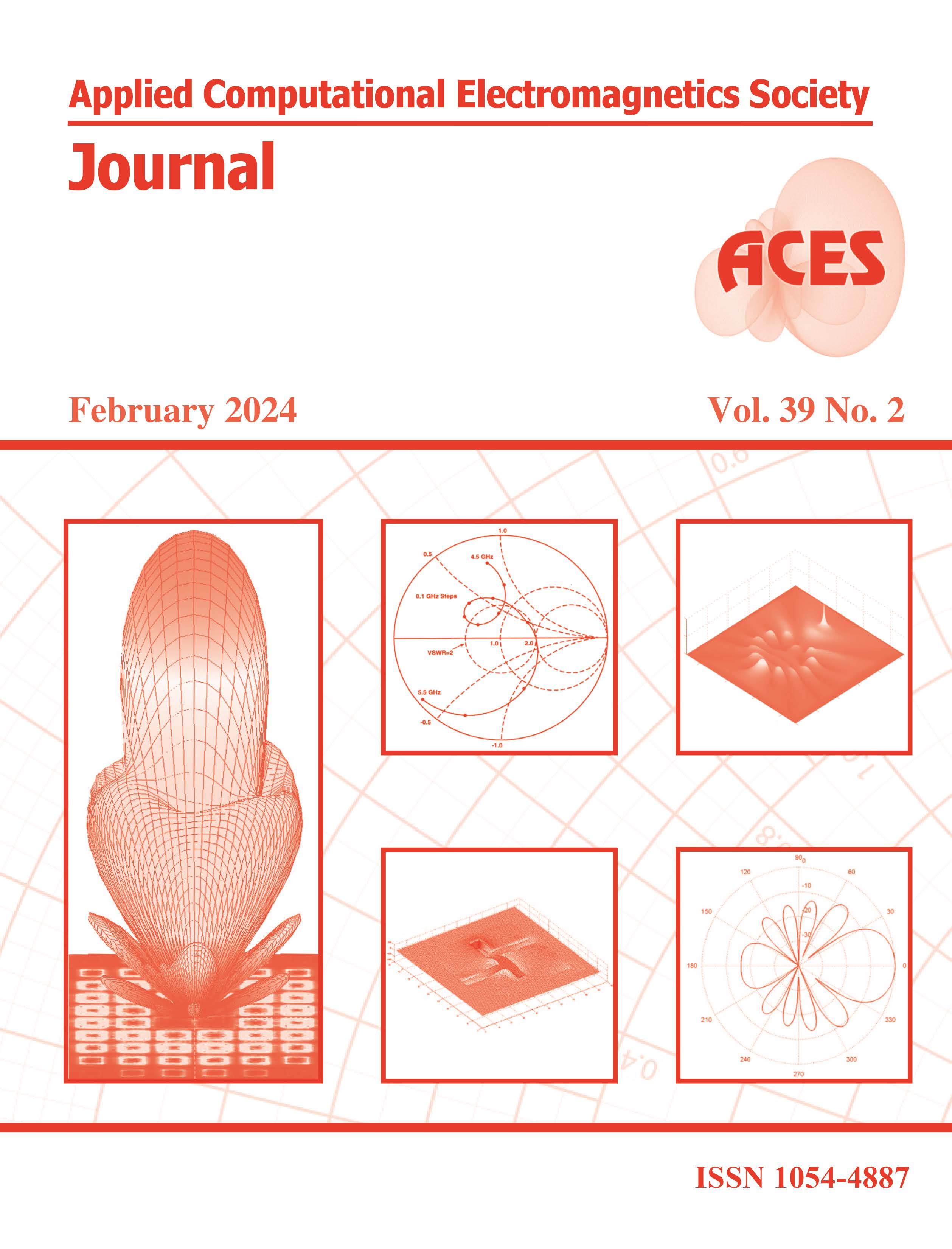Solving Surface-volume Integral Equations for PEC and Inhomogeneous/Anisotropic Materials with Multibranch Basis Functions
DOI:
https://doi.org/10.13052/2024.ACES.J.390203Keywords:
Block diagonal preconditioner, MB-RWG, MB-SWG, surface-volume integral equations (SVIEs)Abstract
Multibranch basis functions have been confirmed to be effective for local refinement of domain decomposition methods in the application of solving surface and volume integral equations. Surface-volume integral equations (SVIEs) are applied for solving the hybrid electromagnetic scattering problems involving perfect electric conductors (PEC) and dielectrics, especially inhomogeneous and anisotropic media. In this paper, multibranch Rao-Wilton-Glisson basis functions (MB-RWGs) are applied in conjunction with multibranch Schaubert-Wilton-Glisson basis functions (MB-SWGs) for solving the SVIEs. Block diagonal preconditioners (BDPs) are used to accelerate the iteration convergence based on generalized minimum residual (GMRES) algorithms. The numerical results demonstrate the accuracy of the multibranch basis functions in solving SVIEs, and also show that proper BDPs can accelerate the iteration convergency.
Downloads
References
S. M. Rao, D. R. Wilton, and A. W. Glisson, “Electromagnetic scattering by surfaces of arbitrary shape,” IEEE Trans. Antennas Propagat., vol. 30, no. 3, pp. 409-418, 1982.
P. Yla-Oijala and M. Taskinen, “Well-conditioned Müller formulation for electromagnetic scattering by dielectric objects,” IEEE Trans. Antennas Propagat., vol. 53, no. 10, pp. 3316-3323, Oct.2005.
S. Huang, G. Xiao, Y. Hu, R. Liu, and J. Mao, “Multibranch Rao-Wilton-Glisson basis functions for electromagnetic scattering problems,” IEEE Trans. Antennas Propagat., vol. 69, no. 10, pp. 6624-6634, Oct. 2021.
F. P. Andriulli, F. Vipiana, and G. Vecchi, “Hierarchical bases for nonhierarchic 3-D triangular meshes,” IEEE Trans. Antennas Propagat., vol. 56, no. 8, pp. 2288-2297, Aug. 2008.
D. H. Schaubert, D. R. Wilton, and A. W. Glisson, “A tetrahedral modeling method for electromagnetic scattering by arbitrarily shaped inhomogeneous dielectric bodies,” IEEE Trans. Antennas Propagat., vol. 32, no. 1, pp. 77-85, Apr.1984.
L. M. Zhang and X. Q. Sheng, “Solving volume electric current integral equation with full- and half-SWG functions,” IEEE Antennas and Wirel. Propaga. Lett., vol. 14, pp. 682-685, 2015.
R. Liu, G. Xiao, S. Huang, and Y. Hu, “Multibranch Schaubert-Wilton-Glisson basis functions for electromagnetic scattering problem,” IEEE Trans. Antennas Propagat., vol. 70, no. 4, pp. 3100-3105, Apr. 2022.
R. R. Chang, K. Chen, J. Wei, and M. S. Tong, “Reducing volume integrals to line integrals for some functions associated with Schaubert-Wilton-Glisson basis functions,” IEEE Trans. Antennas Propagat., vol. 69, no. 5, pp. 3033-3038, May 2021.
C. C. Lu and W. C. Chew, “A coupled surface-volume integral equation approach for the calculation of electromagnetic scattering from composite metallic and material targets,” IEEE Trans. Antennas Propagat., vol. 48, no. 12, pp. 1866-1868, Dec. 2000.
Q. M. Cai, Y. W. Zhao, W. F. Huang, Y. T. Zheng, Z. P. Zhang, Z. P. Nie, and Q. H. Liu, “Volume surface integral equation method based on higher order hierarchical vector basis functions for EM scattering and radiation from composite metallic and dielectric structures,” IEEE Trans. Antennas Propagat., vol. 64, no. 12, pp. 5359-5372, Dec. 2016.
A. C. Yucel, L. J. Gomez, and E. Michielssen, “Internally combined volume-surface integral equation for EM analysis of inhomogeneous negative permittivity plasma scatterers,” IEEE Trans. Antennas Propagat., vol. 66, no. 4, pp. 1903-1913, Apr. 2018.
B. J. Ward, “Hybrid surface electric field volume magnetic field integral equations for electromagnetic analysis of heterogeneous dielectric bodies with embedded electrically conducting structures,” IEEE Trans. Antennas Propagat., vol. 69, no. 3, pp. 1545-1552, Mar. 2021.
W. D. Li, W. Hong, and H. X. Zhou, “An IE-ODDM-MLFMA scheme with DILU preconditioner for analysis of electromagnetic scattering from large complex objects,” IEEE Trans. Antennas Propagat., vol. 56, no. 5, pp. 1368-1380, May 2008.
B. Kong, X. W. Huang, and X. Q. Sheng, “A discontinuous Galerkin surface integral solution for scattering from homogeneous objects with high dielectric constant,” IEEE Trans. Antennas Propagat., vol. 68, no. 1, pp. 598-603, Jan.2020.
S. Z. Gu, L. Zhang, D. M. Yu, K. W. Xu, L. M. Si, and X. M. Pan, “On preconditioners of the FFT-JVIE for inhomogeneous dielectric objects,” IEEE Trans. Antennas Propagat., vol. 71, no. 6, pp. 5493-5497, June 2023.
S. B. Adrian, A. Dely, D. Consoli, A. Merlini, and F. P. Andriulli, “Electromagnetic integral equations: Insights in conditioning and preconditioning,” IEEE Open Journal of Antennas and Propagation, vol. 2, pp. 1143-1174, Dec. 2021.
X. Antoine and M. Darbas, “An introduction to operator preconditioning for the fast iterative integral equation solution of time-harmonic scattering problems,” Multiscale Sci. Eng., vol. 3, pp. 1-35, Feb. 2021.




